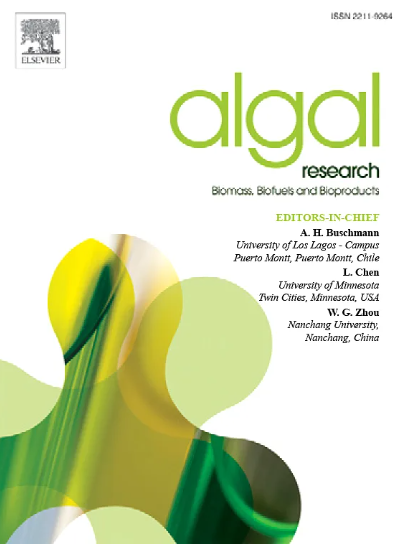珊瑚藻的代谢组受系统发育和环境条件的影响
IF 4.5
2区 生物学
Q1 BIOTECHNOLOGY & APPLIED MICROBIOLOGY
Algal Research-Biomass Biofuels and Bioproducts
Pub Date : 2025-06-14
DOI:10.1016/j.algal.2025.104146
引用次数: 0
摘要
代谢组学是研究环境条件对海洋藻类代谢物变化影响的有力方法。在这里,我们重点研究了甲壳珊瑚藻(CCA),这是一组钙化的红藻,通过与珊瑚的相互作用和对珊瑚礁形成的贡献,对珊瑚礁起着重要的作用。尽管它们具有重要的生态意义,但人们对它们的代谢组及其如何随环境条件和系统发育而变化知之甚少。利用非靶向代谢组学方法,研究了法属波利尼西亚Moorea珊瑚礁上常见的7种CCA物种(Corallinales)的代谢组指纹图谱。我们开发了一种提取方法来表征两种样品类型(全片段和表面)的CCA代谢组,并探讨了CCA在物种、珊瑚礁栖息地和微栖息地之间的化学变化。提取方法成功地表征了CCA代谢组,正如两种样品类型的技术变异性低于生物学变异性所证明的那样。CCA代谢组具有物种特异性,系统发育分类与不同物种的代谢组谱之间存在相关性。此外,某些物种的代谢组学组成在礁后和礁前生境以及暴露和隐蔽微生境之间存在差异。这些结果突出了由系统发育和环境条件介导的CCA代谢组的高度变异性。这项研究为CCA代谢组学变异的来源提供了有价值的见解。它为探索CCA代谢组的生态功能及其作为评估有机和生态系统健康的工具的潜在用途奠定了基础。本文章由计算机程序翻译,如有差异,请以英文原文为准。
The metabolome of crustose coralline algae is driven by phylogeny and environmental conditions
Metabolomics is a powerful approach to investigate the effect of environmental conditions on metabolite variations in marine algae. Here, we focused on crustose coralline algae (CCA), a group of calcifying, red algae which play an important role on coral reefs through their interactions with corals and contribution to coral reef formation. Despite their ecological importance, little is known about their metabolome and how it varies with environmental conditions and phylogeny. Using an untargeted metabolomic approach, we explored the metabolomic fingerprints of seven CCA species (order: Corallinales) commonly found on the coral reefs of Moorea, French Polynesia. We developed an extraction method to characterize the CCA metabolome on two sample types (whole fragment and surface only) and explored the chemical variations of CCA across species, reef habitat and microhabitat. The extraction method successfully characterized the CCA metabolome, as demonstrated by a technical variability lower than the biological variability for both sample types. The CCA metabolome was species-specific and a correlation was found between phylogenetic taxonomy and metabolomic profiles of the different species. Moreover, the metabolomic composition of certain species differed between the back and fore reef habitats and between exposed and cryptic microhabitats. These results highlight a high variability in the CCA metabolome mediated by phylogeny and environmental conditions. This study provides valuable insights into the sources of metabolomic variation in CCA. It lays the groundwork for exploring the ecological functions of the CCA metabolome and its potential use as a tool to assess organismal and ecosystem health.
求助全文
通过发布文献求助,成功后即可免费获取论文全文。
去求助
来源期刊

Algal Research-Biomass Biofuels and Bioproducts
BIOTECHNOLOGY & APPLIED MICROBIOLOGY-
CiteScore
9.40
自引率
7.80%
发文量
332
期刊介绍:
Algal Research is an international phycology journal covering all areas of emerging technologies in algae biology, biomass production, cultivation, harvesting, extraction, bioproducts, biorefinery, engineering, and econometrics. Algae is defined to include cyanobacteria, microalgae, and protists and symbionts of interest in biotechnology. The journal publishes original research and reviews for the following scope: algal biology, including but not exclusive to: phylogeny, biodiversity, molecular traits, metabolic regulation, and genetic engineering, algal cultivation, e.g. phototrophic systems, heterotrophic systems, and mixotrophic systems, algal harvesting and extraction systems, biotechnology to convert algal biomass and components into biofuels and bioproducts, e.g., nutraceuticals, pharmaceuticals, animal feed, plastics, etc. algal products and their economic assessment
 求助内容:
求助内容: 应助结果提醒方式:
应助结果提醒方式:


